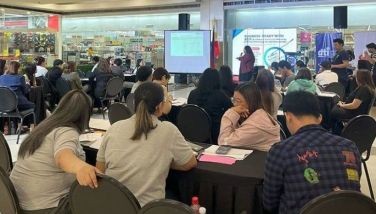Getting back to normal

I realize there may still be some areas that are yet to receive some relief goods, two weeks after Yolanda. And there are definitely some areas that will need relief goods for some more weeks or even months.
At the relief operations center at Villamor Air Base, it would seem that packed relief goods are just piling up and not going anywhere fast. The spirit of volunteerism of our people are now starting to get sapped because DSWD is unable to fully utilize the volunteers showing up and ready to help.
My own colleague, Rosan Cruz, was complaining to me that she and her friends wasted their morning last Sunday trying to help. She said they responded to an appeal of Sec. Cesar Purisima for volunteers to help but they experienced red tape and a disinterested response from officials there.
Rosan wrote Sec Purisima expressing her disappointment and I don’t blame her.
“…the three centers you mentioned are not ready to accept volunteers. My friends and I tried to volunteer yesterday in all three centers – first at NROC, then Cargohaus and lastly in Villamor. All three were closed and all three gave the same reason – auditing.
“We actually asked the DWSD lady in NROC that since they were auditing, we can help in that task and even do some clerical work. Kindly note that there were several groups of people in all three centers eager to volunteer but were idle and waiting to do something…â€
Government must have a good plan on how to harness the private volunteers in times of emergency. The misunderstanding at Villamor between the Oplan Hatid and other volunteers with DSWD shouldn’t have happened… same is true with the problems the NBI had with forensic experts from UP on how to handle the cadavers.
The good news is, there is no scarcity of civic consciousness from Filipinos from all socio economic classes. They have contributed generously of their time and resources to the effort to make it better for the victims of Yolanda. The bad news is, government is not ready to fully harness this positive force.
Two weeks after Yolanda, we should start to move to the next phase – rehabilitation. We should now start to focus on the rebuilding of lives by helping victims build new homes and get new livelihood sources. There are victims eager to get started to rebuild their lives.
Indeed, the C-130s have been disgorging refugees from Tacloban, many of them with no relatives in Metro Manila and no idea of what they are going to do next. If it is any comfort to them, neither does government. Cebu and Metro Manila will have problems soon unless there is a viable long term plan for the refugees.
Getting back to normal for those left behind in the disaster zones will probably take time and a lot of effort. Still, it is not too early to talk of normal times. Even in Tacloban which was almost obliterated by Yolanda, life is slowly going back to normal.
Banks and stores are opening up again and the city is being cleaned of the typhoon debris. Soon enough, the large contingent of foreign donors will be gone and we are back to fixing our own problems by ourselves again.
That’s the scary part specially if there is no credible plan on how to rebuild the devastated areas. All eyes are now on Energy Secretary Jericho Petilla who has been designated as the overall rehabilitation plan chief.
Petilla seems competent. He has a strong interest in ensuring success as a former governor of Leyte and he seems to be the rare Cabinet official willing to lose his job if he fails. He said he will resign if power is not restored in most of Leyte by Christmas.
The Cabinet rehab plan is yet to be submitted to P-Noy this week. Hopefully, it will also address a number of things that needs fixing. Otherwise, we would have wasted a good opportunity to do things right.
Again, there is a need to get volunteers involved in rehabilitation. We need to encourage groups like the one to which Starweek editor Doreen Yu belongs to. Doreen’s group is working to give fishing bancas to fisherfolks who lost their bancas to Yolanda’s fury.
Then, there is the obviously government task to do a better job of planning cities like Tacloban. Indeed, there is a necessity for better urban planning in all our key cities and municipalities but the “puede na†and “bahala na†mentality as well as petty politics make that impossible. Our recent experiences with floods and typhoons make this task urgent.
I have heard proposals that government should declare a ban on building in geographically hazardous areas. The 200 meters standard we now have for houses near the beach is probably no longer tenable. So are the designs of some houses and the building materials used.
Bill Luz, the co-chair of the National Competitiveness Council representing the private sector talks of important, if not compulsory features for any planned reconstruction program. Some of these are:
• Permanent resettlement areas for residents to ensure that they live outside the danger zones identified in geohazard maps. Initially, bunk houses will be built so people can move out of tents as the permanent homes are constructed.
Livelihood opportunities, along with credit and microcredit, will also need to be attended to. The business community’s help will be needed here.
• Reconstruction of public buildings (e.g., hospitals, schools, airports, ports, government offices, markets, etc.) from standardized designs which are more disaster-resilient.
Building specifications will be set to withstand the relevant risks such as wind speed, rain and flood, storm surge or earthquake (depending on location). The basic objective is to ensure that public facilities can remain operational even after disaster strikes.
• Design and construction of all-weather, disaster-resilient public infrastructure.
Of course it goes without saying that enforcement of the National Building Code and other such rules will have to become stricter. Structures not only need to be designed and built right, they also need to be built in the right place.
It is also going to be very useful if LGU officials undergo disaster response training. They should be made familiar with the use of geohazard maps and to understand terminology used by weather forecasters.
It will help immensely if we ask the Japanese government to help in the normalization process by sharing their post tsunami experiences with the affected provinces. We will find out that the healing process takes time. But we will also see how the Japanese government responded to the immediate needs of victims for housing and getting social relationships back.
I understand that the Japanese came up with creative means to quickly provide housing, for example. I saw a report on how they used ordinary shipping containers as the core of a temporary decent housing for the victims. Indeed, I wouldn’t have guessed those attractive apartments started off as shipping containers.
At this point, I think we are done with basic relief goods. I am afraid we will end up with some of these relief goods rotting in warehouses undistributed.
We have to move on to housing. If we still want to help, we can help with groups like Gawad Kalinga and Habitat for Humanity, groups that are working on housing projects for the typhoon victims.
There are also things the private business sector must do in the wake of Super Typhoon Yolanda. They need to review, update and upgrade their disaster recovery programs. Present plans may not have factored a typhoon as powerful as Yolanda. Their risk managers must be able to satisfactorily answer the question, what happens if a Yolanda hits Metro Manila?
Indeed, the BPOs are most vulnerable to a Yolanda type catastrophe. Yet, they cannot miss a beat nor use a typhoon as an excuse not to be on line all the time. Many BPOs are even in the MOA area close to Manila Bay where a recent storm surge, a lot weaker than Yolanda, caused serious damage to Sofitel.
One last thing… we are also so focused on Yolanda victims I am afraid we have forgotten the Bohol earthquake and the Zamboanga siege evacuees. These victims of natural and man-made calamities are still waiting to normalize their lives. They should be part of any national rehabilitation plan.
Consensus
Mar Roxas said there is no need for a ground commander managing the relief operation because they manage by consensus. To reach consensus, they must have a conference. A conference was once described as the confusion of one man multiplied by the number present.
That explains everything.
Boo Chanco’s e-mail address is bchanco@gmail.com. Follow him on Twitter @boochanco
- Latest
- Trending


























